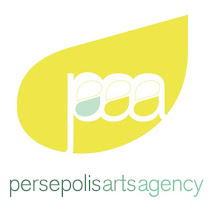A picture is worth a thousand words, or so it is said, still many works are briefly titled. To learn the titles often times one must look to the description of the piece, but on occasion there is no further investigation needed than the painting itself. Many of Shaun Richards works feature the title of the piece prominently within the image.
Words provide information, often direction. Images provide a window, a limited view of something specific. Either can launch our minds to ponder concepts, however, pair them together, and there is less wondering through mental ramblings. The focus becomes more acutely directed.
Here the words are not separate from the work, but part of it. They add depth and definition. In some pieces it is as if the words answer the question of what happened without robbing the image of the story it offers, or it tells what is lacking without lessening the curiosity. Why does that helicopter seem to be leaving the beautiful, smiling woman on her motorcycle? Why does the image of the man looking through a camera lens leave me looking for something? What happened to make that car flip upside down? The words across the paintings, slightly obscured by the images, offer some answer to these questions. Just a little nudge to ask more questions. I want to know more.
The Green Hill Center in Greensboro, NC is currently displaying works by Shaun Richards along with another local artist. Shaun Richards will also be available for an artist talk on Wednesday, May 18, 2011 from 5:30 to 6:30 p.m.
-Veronica Monique Ibarra
 I don’t know what drew me in first. Maybe it was the red eyes, or the funny spelling of the word “toupee,” or the sarcasm in the “nice comb-over” comment, but this painting suddenly became my favorite detail of the place. I was wondering if a potential buyer would offer more just to keep it. “Yes, we’re interested in your apartment. We will agree to pay our own closing costs if you will agree to leave all fixtures, as well as the painting of the Donald. And that’s my final offer.” A closer look at the work of art revealed hidden messages, which made it even more intriguing. While everyone else had already moved onto the master bedroom, I was still stuck in the kitchen questioning the motives of the artist. Was this a child who painted this, given the misspellings? What do those hidden messages read? Where did the owner even find this painting, and how much did he or she pay? And, most importantly, does it come with the unit? Because as we all know, a great piece of art is what truly makes a house a home.
I don’t know what drew me in first. Maybe it was the red eyes, or the funny spelling of the word “toupee,” or the sarcasm in the “nice comb-over” comment, but this painting suddenly became my favorite detail of the place. I was wondering if a potential buyer would offer more just to keep it. “Yes, we’re interested in your apartment. We will agree to pay our own closing costs if you will agree to leave all fixtures, as well as the painting of the Donald. And that’s my final offer.” A closer look at the work of art revealed hidden messages, which made it even more intriguing. While everyone else had already moved onto the master bedroom, I was still stuck in the kitchen questioning the motives of the artist. Was this a child who painted this, given the misspellings? What do those hidden messages read? Where did the owner even find this painting, and how much did he or she pay? And, most importantly, does it come with the unit? Because as we all know, a great piece of art is what truly makes a house a home.
